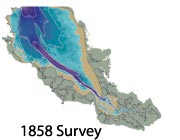|
Deposition, Erosion, and Bathymetric Change in South San Francisco Bay: 1858-1983 |
 |
Since the California Gold Rush of 1849, sediment deposition, erosion, and the
bathymetry of South San Francisco Bay have been altered by both natural processes
and human activities. Historical hydrographic surveys can be used to assess how
this system has evolved over the past 150 years. The National Ocean Service (NOS)
(formerly the United States Coast and Geodetic Survey (USCGS), collected five
hydrographic surveys of South San Francisco Bay from 1858 to 1983. Analysis of
these surveys enables us to reconstruct the surface of the bay floor for each
time period and quantify spatial and temporal changes in deposition, erosion,
and bathymetry.
|
|
|
Science Support for Wetland Restoration in the Napa-Sonoma Salt Ponds, San Francisco Bay Estuary |
![[Black-necked stilts]](/peth04/20041025052647im_/http://www.sfbay.wr.usgs.gov/access/saltponds/images/blackstiltsm.jpg) |
- The San Francisco Bay estuary has experienced tremendous human population growth during the past 150 years and a subsequent loss of natural habitats and degradation of water quality.
- More than 91% of the tidal wetlands has been
lost to reclamation for farmland, salt evaporation ponds, and
residential or industrial property.
- Many native species dependent on tidal wetlands are now endangered or candidate species for listing.
The goal of this research project was to examine the ecological and hydrological function of the Napa-Sonoma salt ponds and their importance for waterbirds, including integrated studies on primary productivity, macroinvertebrates, plants, and fishes. This progress report presents the preliminary research results from the first year of the fieldwork. |
|
|
Historical Bathymetric Change in Suisun Bay: 1867-1990 |
![[Satellite image of Suisun Bay]](/peth04/20041025052647im_/http://www.sfbay.wr.usgs.gov/access/Bathy/suisunbay/images/aerialsm.jpg) |
These web pages detail the change in sedimentation in
Suisun Bay from 1867 to 1990 by using Geographic Information Systems
for analyses. The change is based on historical hydrographic surveys
made by the U.S. Coast and Geodetic Survey (USCGS) and the National
Ocean Survey (NOS). The Suisun Bay survey timeline shows the occurrence
of these hydrographic surveys in relation to activities such as
hydraulic mining and flood control projects in central California.
Tidal flat area change is studied where data was available.
|
|
|
Sedimentation Changes in San Pablo Bay |
![[Bathymetric Change Map of San Pablo Bay]](/peth04/20041025052647im_/http://www.sfbay.wr.usgs.gov/access/images/pablo.gif) |
Sedimentation in San Pablo Bay changed dramatically during the past 140 years. From 1856 (the earliest detailed hydrographic survey) until at least the late 1800's hydraulic mining debris filled San Pablo Bay. During the early 1900's sedimentation slowed and, in the late 1900's, San Pablo Bay was erosional as the supply of hydraulic mining debris decreased and Central Valley water projects diminished sediment supply to the Delta and Bay. These pages show change in sedimentation using computer analysis and display of historical hydrographic surveys made by the US Coast and Geodetic Survey (USCGS) and the National Ocean Survey (NOS). |
|
|
Morphodynamic Conditions at the Sonoma Baylands Restoration Site |
![[Sonoma Baylands Restoration Site Photo]](/peth04/20041025052647im_/http://www.sfbay.wr.usgs.gov/access/images/sonoma_bay.gif) |
To preserve a viable wetland habitat around the Bay, management agencies have begun to identify the threats to existing wetlands and to determine viable strategies for wetland restoration in areas that are now diked agricultural land or salt evaporating ponds. Those agencies, in coordination with other appropriate groups, have initiated the first major wetland restoration endeavor to use dredge spoils, the Sonoma Baylands Restoration Project. USGS is studying how the structure and form of the wetland changes over time to aid agencies in evaluating this important experiment. |
|
|
Sonoma Baylands Wetland Restoration: Supporting Geochemical Studies |
 |
San Francisco Bay has lost most of its freshwater wetlands
and salt marshes through dikes, fill, and sedimentation. An ambitious
project to restore some of those wetlands is taking place at Sonoma
Baylands. USGS is supporting the effort by investigating the occurrence,
fate, and accumulation of organic contaminants in sediments and
biota. Some preliminary results and conclusions are now available.
|
|
|
Wetlands and Water Quality Change Detection in San Francisco Bay Ecosystem Using Remotely Sensed Images |
![[Landsat image from April 4, 1973 (wet year)]](/peth04/20041025052647im_/http://www.sfbay.wr.usgs.gov/access/images/LS73sm.gif)
![[Landsat image from April 6, 1983 (wet year)]](/peth04/20041025052647im_/http://www.sfbay.wr.usgs.gov/access/images/LS83sm.gif)
![[Landsat image from April 11, 1988 (dry year)]](/peth04/20041025052647im_/http://www.sfbay.wr.usgs.gov/access/images/LS88sm.gif) |
|
Landsat images from April 4, 1973 (wet year), April 6, 1983 (wet year) and April 11, 1988 (dry year) are analyzed to identify and map changes to wetlands over the past 20 years.
USGS scientists are using Landsat images to map changes in wetlands for San Francisco Bay. Landsat movies showing differences in brightness levels from 1973 to 1983 that may correlate with suspended sediment are an important contribution to the study. |
|
USGS Provides Long-Term Perspective for Integrated Science |
![[Detailed maps showing urban growth, wetland change, and earthquake epicenters]](/peth04/20041025052647im_/http://www.sfbay.wr.usgs.gov/access/images/IntSci_small.gif) |
These detailed maps integrate urban growth, wetland change, and major earthquake epicenters in the SF Bay Area over time, 1850-1990. |
- USGS integrates many different kinds of data about the Earth's land surface.
- Records of human-induced phenomena, such as land use change, are crucial to understanding the ways that humans have transformed the landscape and the way the landscape functions. In the accompanying graphic, the red indicates urban growth in the San Francisco Bay area over the last 150 years while the green shows losses in tidal wetlands for the same period.
- Records of natural phenomena, such as earthquakes, are vital to protecting human health and safety; the yellow dots on each image indicate the location of earthquakes, magnitude 6.0 and above, occurring prior to the date of the image.
|
![[Landsat image from April 4, 1973 (wet year)]](/peth04/20041025052647im_/http://www.sfbay.wr.usgs.gov/access/images/LS73sm.gif)
![[Landsat image from April 6, 1983 (wet year)]](/peth04/20041025052647im_/http://www.sfbay.wr.usgs.gov/access/images/LS83sm.gif)
![[Landsat image from April 11, 1988 (dry year)]](/peth04/20041025052647im_/http://www.sfbay.wr.usgs.gov/access/images/LS88sm.gif)

![[Black-necked stilts]](/peth04/20041025052647im_/http://www.sfbay.wr.usgs.gov/access/saltponds/images/blackstiltsm.jpg)
![[Satellite image of Suisun Bay]](/peth04/20041025052647im_/http://www.sfbay.wr.usgs.gov/access/Bathy/suisunbay/images/aerialsm.jpg)
![[Bathymetric Change Map of San Pablo Bay]](/peth04/20041025052647im_/http://www.sfbay.wr.usgs.gov/access/images/pablo.gif)
![[Sonoma Baylands Restoration Site Photo]](/peth04/20041025052647im_/http://www.sfbay.wr.usgs.gov/access/images/sonoma_bay.gif)

![[Detailed maps showing urban growth, wetland change, and earthquake epicenters]](/peth04/20041025052647im_/http://www.sfbay.wr.usgs.gov/access/images/IntSci_small.gif)